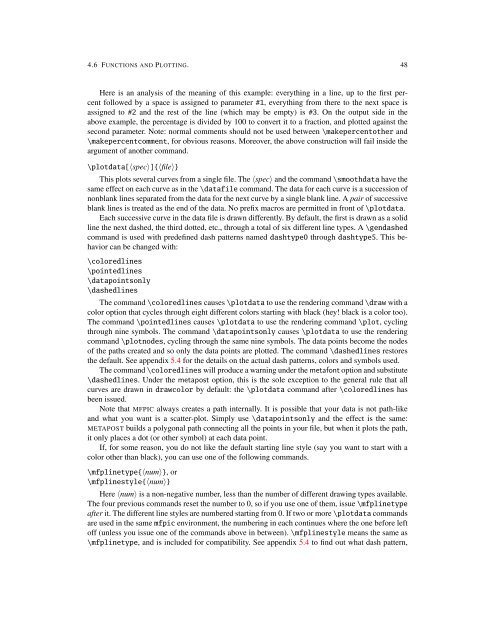Create successful ePaper yourself
Turn your PDF publications into a flip-book with our unique Google optimized e-Paper software.
4.6 FUNCTIONS AND PLOTTING. 48<br />
Here is an analysis of the meaning of this example: everything in a line, up to the first percent<br />
followed by a space is assigned to parameter #1, everything from there to the next space is<br />
assigned to #2 and the rest of the line (which may be empty) is #3. On the output side in the<br />
above example, the percentage is divided by 100 to convert it to a fraction, and plotted against the<br />
second parameter. Note: normal comments should not be used between \makepercentother and<br />
\makepercentcomment, for obvious reasons. Moreover, the above construction will fail inside the<br />
argument of another command.<br />
\plotdata[〈spec〉]{〈file〉}<br />
This plots several curves from a single file. The 〈spec〉 and the command \smoothdata have the<br />
same effect on each curve as in the \datafile command. The data for each curve is a succession of<br />
nonblank lines separated from the data for the next curve by a single blank line. A pair of successive<br />
blank lines is treated as the end of the data. No prefix macros are permitted in front of \plotdata.<br />
Each successive curve in the data file is drawn differently. By default, the first is drawn as a solid<br />
line the next dashed, the third dotted, etc., through a total of six different line types. A \gendashed<br />
command is used with predefined dash patterns named dashtype0 through dashtype5. This behavior<br />
can be changed with:<br />
\coloredlines<br />
\pointedlines<br />
\datapointsonly<br />
\dashedlines<br />
The command \coloredlines causes \plotdata to use the rendering command \draw with a<br />
color option that cycles through eight different colors starting with black (hey! black is a color too).<br />
The command \pointedlines causes \plotdata to use the rendering command \plot, cycling<br />
through nine symbols. The command \datapointsonly causes \plotdata to use the rendering<br />
command \plotnodes, cycling through the same nine symbols. The data points become the nodes<br />
of the paths created and so only the data points are plotted. The command \dashedlines restores<br />
the default. See appendix 5.4 for the details on the actual dash patterns, colors and symbols used.<br />
The command \coloredlines will produce a warning under the metafont option and substitute<br />
\dashedlines. Under the metapost option, this is the sole exception to the general rule that all<br />
curves are drawn in drawcolor by default: the \plotdata command after \coloredlines has<br />
been issued.<br />
Note that MFPIC always creates a path internally. It is possible that your data is not path-like<br />
and what you want is a scatter-plot. Simply use \datapointsonly and the effect is the same:<br />
METAPOST builds a polygonal path connecting all the points in your file, but when it plots the path,<br />
it only places a dot (or other symbol) at each data point.<br />
If, for some reason, you do not like the default starting line style (say you want to start with a<br />
color other than black), you can use one of the following commands.<br />
\mfplinetype{〈num〉}, or<br />
\mfplinestyle{〈num〉}<br />
Here 〈num〉 is a non-negative number, less than the number of different drawing types available.<br />
The four previous commands reset the number to 0, so if you use one of them, issue \mfplinetype<br />
after it. The different line styles are numbered starting from 0. If two or more \plotdata commands<br />
are used in the same <strong>mfpic</strong> environment, the numbering in each continues where the one before left<br />
off (unless you issue one of the commands above in between). \mfplinestyle means the same as<br />
\mfplinetype, and is included for compatibility. See appendix 5.4 to find out what dash pattern,

















